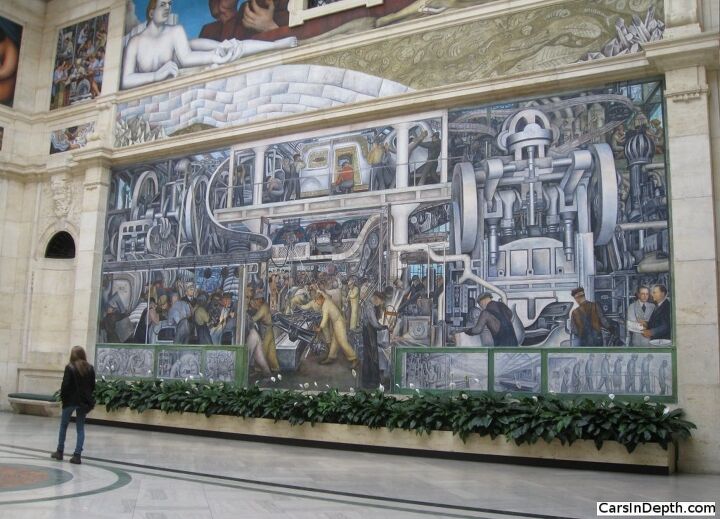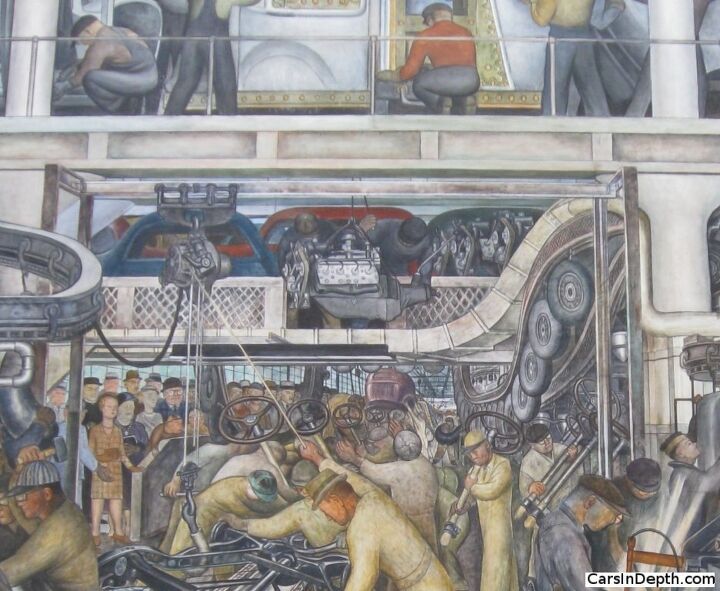Another Post About Diego Rivera's "Detroit Industry" Murals, Thanks to DetNews Writer Rob Stanczak

Detroit Institute of Arts, Rivera Court, South Wall, “Detroit Industry” – Diego Rivera 1933
Last week we ran a post of mine about “Detroit Industry”, the murals that Diego Rivera painted for Edsel Ford in the main court of the Detroit Institute of Arts. More accurately, the post was about how a couple of artists, the Perre twins, commissioned to paint a mural in a new Detroit building, a commission inspired by Rivera’s work, claimed to know much about the artist and Detroit, but haven’t ever bothered to actually see Rivera’s Detroit masterpiece with their own eyes. That post was inspired by an article at the Detroit News by Rob Stanczak, from whence artist David Perre’s quote, “We have not seen it in person” jumped out at me. In our post, I linked to Rob Stanczak‘s article and, because I couldn’t find any photos of the Perres’ new mural that weren’t rights reserved, I used the DetNews’ video accompanying Rob Stanczak‘s article to illustrate my own. While not a formal citation per Modern Language Association guidelines, the link and DetNews video still gave our readers a couple of ways that they could access Rob Stanczak‘s work.
As writers, it’s almost always a great pleasure when we get contacted by a person or writer who has inspired our work. Rob Stanczak graciously took his time to, point by point, explain the shortcomings in my post and also “thank” me by name for “parroting” his article without “direct attribution”. We always appreciate feedback, though one wonders how if my article so slavishly parroted Rob Stanczak‘s original story, why Rob Stanczak felt the post needed “clarification”?
Detroit Institute of Arts, Rivera Court, North Wall, “Detroit Industry” – Diego Rivera 1933
I realize now that I did owe Rob Stanczak of the Detroit News more direct attribution and attention in my original post. Rather than just use his article as a source for quotes, I should also have mentioned that while Rob Stanczak quoted Davide Perre about not actually seeing the actual Rivera murals, Rob Stanczak‘s vision is so seemingly blinded by the pretensions of today’s fine art world, he failed to explore the pretentiousness of the Perres. They are visual artists, internationally known muralists who bragged about having visited “most parts” of Detroit, knowing the city “very well”, who feel artistically and politically simpatico with “Diego”, without having seen Detroit’s great murals, which Rivera considered his best work. That central point of my post was one that Rob Stanczak didn’t make in Rob Stanczak‘s DetNews article that Rob Stanczak now says that I parroted. I hope that’s sufficient direct attribution for Rob Stanczak.
Detroit Institute of Arts, Rivera Court, West Wall, “Detroit Industry” – Diego Rivera 1933
After I posted the story about the Perres, it occurred to me that I hadn’t personally seen the Rivera murals in some time and that it would take me less time to drive to Detroit’s cultural center and see them than it would have taken Davide Perre and his brother to walk up Woodward to the DIA, so last Sunday afternoon I drove down to the art museum to see and photograph Rivera’s 27 murals. While I was able to enjoy Rivera’s work, it was late in the afternoon on a grey, early December day, the murals are primarily naturally lit through the large skylight above, and flash photography is not allowed in the DIA so photography was pointless. I came back later in the week when I noticed the sun peaking through the clouds as it approached its apogee in the sky at the noon hour.
Detroit Institute of Arts, Rivera Court, East Wall, “Detroit Industry” – Diego Rivera 1933
I shoot all my photography and video in 3D and if I need a mono image, I’ll just use a left or right photo. Still, taking photographs of paintings usually isn’t the best application for 3D photography. Sculpture, of course, but paintings not so much. However, I realized that the Rivera court at the DIA is a perfect application for stereo photography because of the large scope of the work and the space wherein it was painted. Along with depth and shape, stereo vision gives us a sense of space. Often when you see photographs of Detroit Industry, the images are cropped closely to the individual panels’ edges, and you can’t really see how massive they are and how they visually fit into the large room where they are located. Actually, the two main paintings on the north and south walls of the court are so large, 22′ x 72′, that without a wide angle lens it’s difficult to get them completely framed in a photograph, there’s just not enough room to step far enough back.
One of the murals’ portraits, their patron, Edsel Ford, second from right.
You could spend hours, days, maybe years studying all of the details in Detroit Industry, but two things stood out to me in my most recent visits. The panel on the south wall depicts the assembly of Ford cars at the Rouge complex circa 1932-33. That’s when Ford introduced their legendary flathead V8 engine, and right in the center of the painting, like the focus of some religious artwork, is a completed Ford V8.
At the center of the south wall’s fresco is a flathead Ford V8
The other thing that I noticed is the contrast between the people in the painting with no distinguishing characteristics, almost like they came from molds, automatons, and those people in the painting that are clearly portraits, like those of Edsel Ford and Albert Kahn.
Archietct Albert Kahn, who designed the Rouge complex portrayed in Detroit Industry
Oh, and couple more small details. David Perre talked about how Rivera had to suppress his politics in this work. Oddly, the word “communist” never passed Perre’s lips and while it’s true that Detroit Industry is less explicitly political than Rivera’s censored Rockefeller Center work, having no portraits of Lenin, one of the panels flanking the doorway on the court’s west wall depicts a burly worker right at eye level. He has a small sledge hammer in his right hand, and the gauntlet of his right glove features a red star. I didn’t notice one, but perhaps somewhere in that panel there’s also a sickle.
Is the hammer and red star a political statement?
Also, while the work is titled “Detroit Industry” and while you see all sorts of automobile components depicted, it’s hard to find an image of a complete car, except for a tiny red Ford coupe driving in the far background of the final assembly line depicted on the south wall.
The only complete automobile in the entire work, a little red ’32 Ford coupe way in the background of the final assembly line.
TTAC would like to thank the Detroit Institute of Arts for allowing us to use a tripod in the museum and giving us access to the second floor balcony so you can enjoy these photos, and, of course, great thanks goes to Rob Stanczak without whom my last couple of features here on TTAC just wouldn’t have been possible.
Stereo pics available at Cars In Depth.
Ronnie Schreiber edits Cars In Depth, a realistic perspective on cars & car culture and the original 3D car site. If you found this post worthwhile, you can get a parallax view at Cars In Depth. If the 3D thing freaks you out, don’t worry, all the photo and video players in use at the site have mono options. Thanks for reading – RJS
At the center of the south wall’s fresco is a flathead Ford V8

Ronnie Schreiber edits Cars In Depth, the original 3D car site.
More by Ronnie Schreiber
Latest Car Reviews
Read moreLatest Product Reviews
Read moreRecent Comments
- MaintenanceCosts I hope they make it. The R1 series are a genuinely innovative, appealing product, and the smaller ones look that way too from the early information.
- MaintenanceCosts Me commenting on this topic would be exactly as well-informed as many of our overcaffeinated BEV comments, so I'll just sit here and watch.
- SCE to AUX This year is indeed key for them, but it's worth mentioning that Rivian is actually meeting its sales and production forecasts.
- Kjhkjlhkjhkljh kljhjkhjklhkjh a consideration should be tread gap and depth. had wildpeaks on 17 inch rims .. but they only had 14 mm depth and tread gap measured on truck was not enough to put my pinky into. they would gum up unless you spun the libing F$$k out of them. My new Miky's have 19mm depth and i can put my entire index finger in the tread gap and the cut outs are stupid huge. so far the Miky baja boss ATs are handing sand and mud snow here in oregon on trails way better than the WPs and dont require me to redline it to keep moving forward and have never gummed up yet
- Kjhkjlhkjhkljh kljhjkhjklhkjh Market saturation .. nothing more
























































































































































Comments
Join the conversation
One would think that Stanczak has bigger issues to worry about... Like working in a dying medium in a failed, broken, and rapidly decaying city.
Though Detroit is rapidly turning into the Chichén Itzá of the North, and all you hear is bad news, its good to have some reminders of what is good there. Unfortunately the situation is such that there is talk of selling some great art works to pay their ever increasing debts. I am also astonished that any artist would publicly admit that they were inspired by another artist yet have never seen their work in person. I think I'll skip the Perres' work, if they can't be troubled to go see Rivera-not sure if anyone could keep me away.